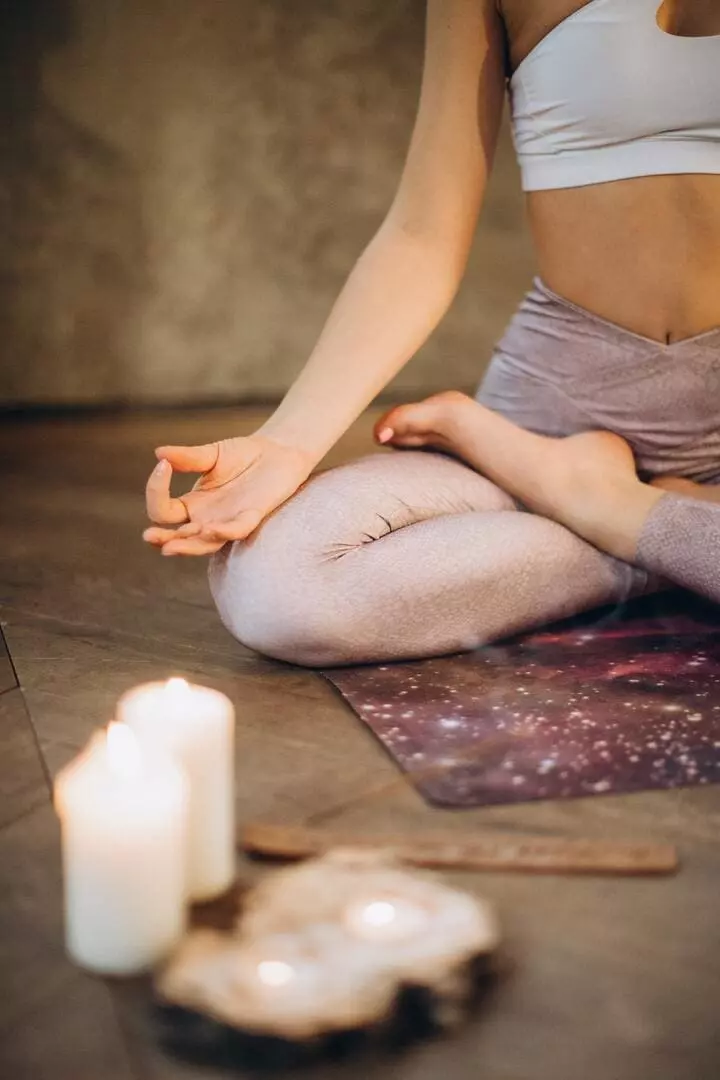What is Meditation? An Easy To Follow Guide You Can Try Today!

So you have heard of meditation and want to try it? What is meditation and what is the process of meditation?
Meditation is a systematic training of your mind to achieve heightened awareness, relaxation, and concentration. The word meditation means different things to different people so I will try and break it down in terms that everyone can understand.
What is Meditation? Let’s Dive Into it…
Meditation can take many forms including prayer or contemplation, mantra repetitions, contemplation on a religious figure or concept, visualization of a calming scene, self-hypnosis, yoga techniques, listening to music with headphones on and eyes closed, reciting the alphabet in your mind emptying your mind.
Meditation is usually done by sitting in a comfortable position either cross-legged or sitting in a chair.
The back should be straight but not stiff. In the West, we usually close our eyes but this isn’t necessary (you should close your eyes in a sitting meditation and open them in a walking meditation). The hands can be rested on your lap or held together in a prayer position.
Subscribe to Create Higher Vibrations!
Get Inspiration and Practical advice straight to your inbox.
The Impact Meditation Has…
Like a stream consciousness ebbs and flows, constantly shifting and changing. But unlike a stream, consciousness is not bound by the physical world.
It is not limited by time or space. You could say that consciousness has unlimited potential. And meditation is one way to harness that potential and change the course of your consciousness.
When you meditate, you are consciously choosing to focus your attention on one specific thing. This could be your breath, a mantra, or a certain visual image.
By focusing your attention in this way, you are training your mind to be more present and aware of each moment. As you become more adept at meditating, you will find that it becomes easier to maintain this state of presence and awareness in your everyday life.
For centuries, meditation has been used as a way of promoting physical and mental well-being. Numerous studies have now shown that there is a scientific basis for these claims.
When we meditate, our bodies go into a state of deep relaxation. This lowers our respiration rate, heart rate, and blood pressure. It also changes our brain wave patterns, moving us into a state of alpha waves.
In this state, we are more calm and relaxed. Meditation has also been shown to lower levels of the stress hormone cortisol. These physiological changes have several positive psychological effects.
We are more able to focus and concentrate. We become more patient and less reactive to stress. We also have more clarity of thought and increased self-awareness. As a result, we are better able to make wise decisions and take appropriate action.
When you meditate, you are training your mind to focus and be more present. In turn, this allows you to better manage stress and anxiety.
Studies have shown that meditation can help with symptoms related to anxiety disorders, depression, sleep disorders, pain issues, and high blood pressure. In addition, meditation can help improve stress management skills, working memory, fluid intelligence, and immunity.
It can also increase self-awareness, empathy, and emotional well-being. So if you’re looking for a way to improve your mental and physical health, consider giving meditation a try.

Meditation Tips For Beginners!
If you are just starting, here are some tips to help you:
Meditation Technique
The process of meditation is simple you find a quiet place where you will not be disturbed and sit to experience inner silence, stillness, and relaxation.
Begin by breathing deeply using your diaphragm and focusing on your breath. This is a great way to experience calming yourself down and focusing your energy inwardly.
Eventually, you can add mantras to this basic meditation practice, such as repeating ‘om’ or observing the thoughts that come into your mind without getting involved in them. You can sit cross-legged or in a chair, whichever is most comfortable for you.
Where to Meditate
Anywhere, really. You can meditate outside, in your backyard, or on a park bench surrounded by nature. You can also find meditation rooms at any yoga studio or wellness center that offers classes or retreats. If all else fails, simply close the door to a room in your home that you don’t normally go into and sit with your eyes closed.
Meditation Music
Any type of music is good for meditation, as long as it’s not distracting. Classical music or nature sounds are popular choices, for guided meditation but you can use whatever makes you feel relaxed. A great trick to create the mood is to play the music softly in the beginning and then turn it louder once you enter your meditative state.
Meditation Posture
Sitting is the most popular meditation posture, but lying down can also be effective if that’s what feels best for you. The key to good posture during meditation is to keep your spine straight and feel like a mountain or tree firmly planted on the earth.
How Long to Meditate?
There is no set rule for how long to meditate, but following the basic steps above you should be able to quickly enter into a meditative state within 5-10 minutes.
Start with what feels comfortable and build from there once you become more experienced. As your meditation practice grows, you could easily spend 30-60 minutes in a session allowing for deep meditation.
Meditation Myths
Many myths about meditation unfortunately prevent people from experiencing the benefits. One popular myth is that you need to sit in the lotus position or do yoga before you meditate.
Not true at all! The only thing important when practicing this simple art is making sure you are comfortable.
Meditation is a powerful tool that is available to everyone willing to give it a try. By taking just 10 minutes out of your day to sit in silence, you’ll be amazed at how much better you feel afterward.
Not only will you have more energy and focus, but also have a greater awareness of the world around you.
What is Meditation? The Different Types…
Mindfulness Meditation
Some cognitive therapies such as MBSR (mindfulness-based stress reduction) and MBCT are among the things that mindful meditation can target. It is a therapy that focuses on the present moment and being open, aware, and accepting.
Many practices of mindfulness meditation have different focuses, including depression. Mindfulness meditation is a practice that focuses on the breath. In doing this, it can help people focus and clear their minds.
This type of meditative practice is important in most types of Buddhist meditation practices. It helps with being more aware, peaceful, less judgmental, and accepting. People can find peace by calming their minds through this type of meditation by practicing focusing on their breath.
Vipassana meditation is probably one of the most popular types of mindfulness meditation. Like mindfulness, it focuses on being aware and accepting, but this type also includes understanding reality as it truly is. To do this, people must learn how to see the world without judgments or preconceived notions that they have not personally experienced.
Chakra Meditation
The Chakras are energy centers in the body that can be used to enhance spiritual growth. There are seven main chakras, and each has a unique purpose, including opening your ability to perceive spiritual properties.
To work on the chakras, people meditate to clear their minds of outside distractions while focusing on the chakra in question.
Mudra Meditation
This type of meditation is focused on specific hand postures and “energizing” the physical body by concentrating the energy found in the body’s acupuncture points.
Mudras are used to help control breathing, focus energies, and refresh parts of the mind that may be feeling overwhelmed. By focusing on the hand positions while meditating, people can unlock their full potential.
Ritual Meditation
This type of meditation is used in various pagan traditions and involves focusing energy on specific goals by reciting spells or chants. It uses both ritualistic actions and words to focus power on creating change to perform physical or mental healing, retrieve lost objects, and more.
Transcendental Meditation
Also known as “TM,” this type of meditation is found in the Hindu tradition and has been popularized by the Beatles, who learned it from Maharishi Mahesh Yogi. It involves sitting comfortably with eyes closed and repeating a mantra given by a teacher that often focuses on all beings or qualities such as “peace,” “strength,” or “calmness.”
Taoist Meditation
Meditation in Taoism is used to align oneself with the energy of the universe. This will bring health, rejuvenate the body, and improve mental clarity.
The Taoists believe that nothing has inherent meaning outside of their beliefs, so anything can be a meditation. Some focus on a breathing exercise, others on specific parts of the body to improve health, while others simply concentrate on being in the present moment.
Christian Meditation
Christian meditation is a means to achieve a closer relationship with God through contemplation. It does not have to involve religion at all, and it can be practiced by anyone who seeks a deeper connection to themselves or their creator or higher power. Christian meditation focuses on different aspects of life outside the self to develop better insight and understanding.
Mantra Meditation
This type of meditation is found mostly in Hinduism, Buddhism, and Jainism. It involves repeating a mantra over and over again to clear the mind and relax the body.
The use of mantras has been around for thousands of years as the meditation resolution to have vibrational sounds that can be used to assert power. By focusing on a mantra during meditation, people can become more aware of their emotions and behavior.
Downfalls of Meditation?
You’ve decided to start meditating. Congratulations! Meditation can have a wide range of benefits, from reducing stress and anxiety to improving sleep and concentration.
However, there are also some potential pitfalls to watch for. It’s easy to expect too much too soon when you’re beginning a new meditation practice.
The fact is that forming a habit that will improve your health and happiness takes time and practice. Be patient with yourself and don’t be discouraged if you don’t see results immediately.
Just like with any new habit, it takes time to develop a regular meditation practice. Stick with it and you’ll be reaping the rewards in no time!
Meditation History…
Meditation is an ancient practice with a long history. While it is often associated with Buddhist traditions, it originated in Asia. The practice began to spread to other parts of the world during the 20th century.
In the West, meditation rose to prominence during the 1960s and 1970s. It was often associated with hippie culture. Today, meditation is practiced by people from all walks of life.
It is used for relaxation, stress relief, and other purposes. Meditation has many benefits, and its popularity is sure to continue to grow in the years to come.
Conclusion…
Meditation is a practice that many people have been working on for centuries. It has become more popular in recent years, but there are still plenty of misconceptions about what it is and how to do it.
We hope the information from this article will help clear up some confusion around meditation and show you why we think it’s worth trying out!
If you’re looking for a teacher to help you begin a regular meditation practice or want to learn more before committing yourself to a session, Let’s Work Together! You can also sign up for our newsletter where we’ll be sending out all sorts of great content like this one every week 🙂



